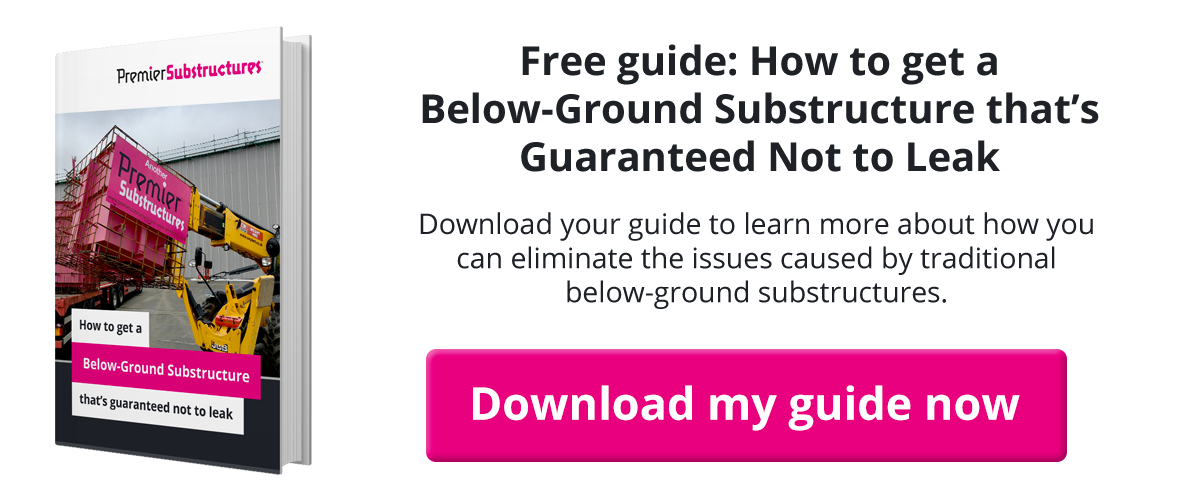Curious about how long it should take to install a sump?
If you need a sump for your factory, facility or business, you’re probably going to want to ensure that the solution you’re choosing is not only 100% watertight, but can also be installed relatively quickly so you’re not looking at a lot of downtime.
However, with traditional methods of below-ground construction (such as in situ concrete), that can be a big ask – if nigh on impossible.
I’m pleased to tell you there’s another way means your sump could be installed 70 – 80% quicker than other methods whilst being proven not to leak; it’s called prefabricated steel.
As a specialist subcontractor who specialises in prefabricated steel substructures, I’m going to tell you more about how long a prefabricated steel sump should take to install, so you can get a better idea of whether it might be the best choice for you.
TIP: Want to know more about prefabricated steel? Read my recent blog: ‘What is Steel Prefabrication Below-Ground and How Does it Work?’.
How long does it take to install a sump?
Since everything prefabricated steel sump is built to be completely bespoke to very unique specifications based on each individual project, I’m afraid I can’t tell you how long it takes to install a sump without knowing the details (such as your exact requirements).
However, what I can do is give you an idea of the time you could save with prefabricated steel. If you were quoted the works initially for, say, in situ concrete, changing the programme to use prefabricated steel instead could save you up to 70 – 80% of time spent on-site.
Need something more specific? Well, I can give you a real-life example of one specific project we completed at Wide Lane, Southampton.
They required one sump as part of their order, and its specifications were 4m long x 2m wide x 3m deep. It was installed in just five days, from excavating the site to completion.
TIP: Bear in mind that for all orders, we need at least six weeks’ lead time in order to design and prefabricate your cellar in our off-site facility before installation.
What other factors can affect installation time?
There are a few vital factors that can affect timescale when installing a prefabricated steel sump – some of these may not be an issue for your project, but I prefer to ensure clients know about them before going any further.
1. Ingoing or outgoing drainage connections
If there are water pipes which connect a flow of water in and out of the structure, this can impact the amount of time on-site, as it means we’ll have to take extra time to connect these into the on-site drainage systems.
2. Logistical constraints
Another big time factor depends on whether there are any logistical constraints. As an example, if our team will be able to excavate the remove the soil from a fairly open space without any difficult ground conditions, we shouldn’t expect any delays.
However, if we’re working in a building with an entrance down a narrow side street with areas of work blocked off by other buildings or obstacles, it could mean things could take longer. We’d also need full access, so work would have to begin on-site before any other planned activities.
If there’s crane access, this will be the fastest way to install your sump. If not, it may take longer to lift small sections of your sump into position. These are all important logistical factors to consider.
2. The size of your cellar
Size matters. Typically, and as a rule of thumb, smaller sumps will be quicker to install. However, saying that, one large sump is usually faster than having to install a few smaller units.
3. The ground conditions
Good ground conditions mean for an easy excavation, and helps to reduce large amounts of temporary works that’d otherwise have to be carried out.
Advice from a specialist subcontractor
It’s tricky for me to go into too much more detail in this blog, although many of the time factors I’ve mentioned above will affect your project regardless of which below-ground construction method you choose.
Despite this, there’s one thing I can say; a prefabricated steel sump will give you a better certainty on timescale than any other method of construction. Something that’s particularly important if you’re concerned about ROI and need your sump installed and working ASAP.
Going back to our project at Wide Lane for a moment, our client approached us due to the fact they were on a tight programme, and saw prefabricated steel as the best way to derisk the programme going over by weeks. The tight tolerances and guaranteed watertightness were also huge factors in their decision.
I’d recommend doing your research, thinking carefully about your options, and also considering the long-term implications of your chosen method – not just the short-term. After all, in situ and precast concrete are both known to leak over time, leading to further work down the line.
Our big question to you is; why can’t you just construct in a way that will ensure your sump is completely watertight in the first place? With prefabricated steel, it is an option.
Conclusion
Could prefabricated steel be a good method to construct and install a sump for your project? Well, it could mean you’ll save a lot of time on-site (70 – 80%), plus there are lots of other benefits as well.
However, if you want to get a better idea of how long it’ll take to install a sump for your specific project, the best thing to do would be to give me a call so I can take down some details, tell you more about your options and answer any questions you may have.
Alternatively, if you just have a simple enough question that I haven’t really answered above, feel free to leave me a comment below – I’m happy to help!

